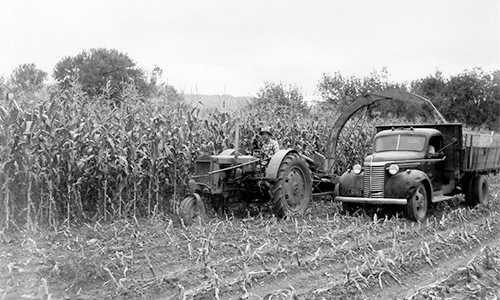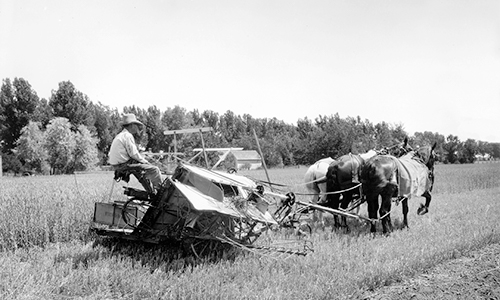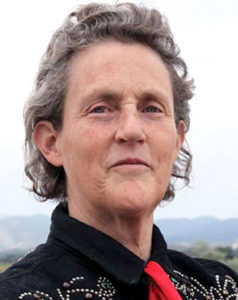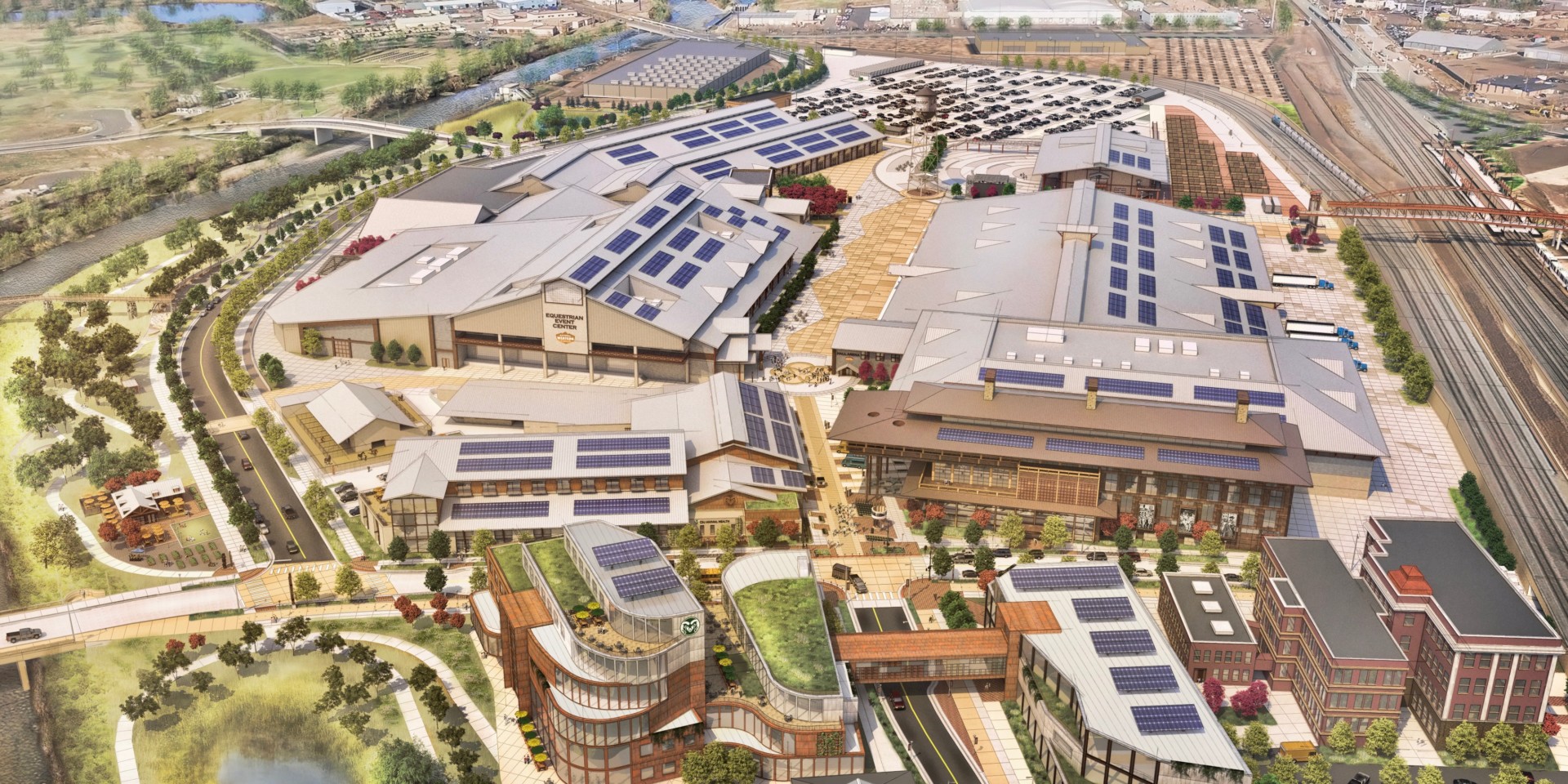THE FIRST COLLEGE: AGRICULTURAL SCIENCES
by Kate Jeracki published Sept. 30, 2019If it weren’t for wheat, there wouldn’t be a Colorado State University.
The Colorado Agricultural College had been authorized by the Territorial Legislature in 1870 – without any funding. Four years later, the legislature finally allocated matching seed money of $1,000 to get the project off the ground, but as the deadline approached, college organizers were a few hundred dollars short of raising their share.
The Collins Grange – the association of local farmers – rode to the rescue, throwing a picnic and planting party to sow 20 acres of wheat on donated land that now includes the Oval. At harvest time, the plot yielded nearly 400 bushels, which was stored in the first structure on the fledgling campus – the Claim Shanty – before it was sold. With cash in hand, Fort Collins was ready when Colorado became a state in 1876 and could accept its 90,000 acres of land from the federal government to fund the college.
And so began the long, mutually beneficial relationship between Colorado’s land-grant college and the state’s agricultural industry that continues today.
“CSU and the College of Agricultural Sciences is where agriculture’s entire value chain, from farm to fork, can come to answer its most pressing questions,” said James Pritchett, interim dean of the college. “The best progress is made when we work together to co-create knowledge. We enter into joint agreements with industry that allow us to work on their products and learn more, answer their questions, and then we can set all that information loose in the world, for the benefit of all.”
“CSU and the College of Agricultural Sciences is where agriculture’s entire value chain, from farm to fork, can come to answer its most pressing questions.”
— James Pritchett, interim dean of the college
At statehood, just a decade after the end of the Civil War, Colorado’s economy was rooted in agriculture. The land grant specified “teaching agriculture and the mechanic arts to all” – by the time the first students were admitted, in 1879, home economics had been added to the curriculum – and CAC’s main focus was preparing young people to improve production of crops and livestock on their family farms.
Despite a statewide property tax that allowed CAC to build its first permanent building, Old Main, its financial situation, and its relationship with the State Board of Agriculture, the precursor of the CSU System Board of Governors, remained rocky through the tenure of several college presidents. Public apathy toward the need for such an institution and legislative inaction played a huge role; another area of ongoing contention was the proper place of research into untried methods of farming.
Research cornerstone
The challenge of finding new ways to help agriculture prosper in Colorado’s arid climate attracted a number of talented faculty to the college. They worked on creating more efficient techniques of irrigation, developing plant varieties that would thrive at high altitude, and combatting diseases that could decimate herds. Research became a cornerstone of what is now the College of Agricultural Sciences at CSU; the experimental farm near Wellington originally covered most of today’s main campus.



As college enrollment grew along with the population of Colorado in the late 1800s, areas of research became more specialized. Divisions of the college devoted solely to engineering and veterinary medicine were created, although students took classes in all three divisions as well as in subjects such as English and mathematics during their time on campus.
When the first National Western Stock Show was held in Denver in 1909, the Agricultural College was there. Not only did students load their prize steers, hogs and sheep on to railroad cars for the trip to the big city to compete – the school was banned for a few years to give others a chance at top prizes – but the largest gathering of livestock producers in the West was also a place for faculty to learn and share new methods and best practices that they brought back to students.
Global impact

Over the past 150 years, there have been many areas where CSU faculty research has had a significant impact on global agriculture, from championing humane livestock handling techniques devised by Professor Temple Grandin to water-efficient farming practices that produce more crop per drop. Crop breeding programs have developed new strains of barley and hops for the brewing industry and a variety of wheat that produces white flour with as much nutrient value as whole wheat.
At the nine – soon to be 10 – agricultural experiment stations operated around the state, CSU applies specialized expertise to specific challenges, whether it’s growing the juiciest peaches on the Western Slope or producing potatoes that can thrive despite a shrinking aquifer in the San Luis Valley.
Such agricultural innovation will continue – must continue, according to Pritchett – to meet the looming challenges of feeding a global population projected to reach 10 billion by midcentury.
“Our biggest challenge is to create and maintain safe, secure, and sustainable food systems to the benefit of humans, animals and our environment,” he said. “And as the overall population grows, so will the number of people with the resources to be considered middle class, to about 2 to 3 billion. With that change in demographics, there is a change in food preferences, and the food industry asks more of agricultural producers to meet the new demands.”
Education for the future

As part of the National Western Center, the CSU System will construct three buildings at a main crossroads in Denver.
Students who enroll in the College of Agricultural Sciences have undergone their own demographic shift, with nearly two-thirds coming to CSU with an interest in animals or food systems but without a background in agriculture. So the curriculum has shifted to make sure everyone starts from the same foundation for success.
“First-year students spend a semester on the experimental farm (ARDEC), getting their hands dirty, while taking classes in the history and economics of agriculture,” Pritchett said. “This gives students who may have never been on a farm real experience, while at the same time providing a familiar space for those from rural areas who may still be adjusting to the big city of Fort Collins.”
The next agricultural experiment station will be the first in an urban setting – at the redeveloped National Western Center, a project in partnership with the City and County of Denver, History Colorado, the Denver Museum of Nature and Science, the National Western Stock Show and CSU, with a broad focus on entertainment, food, animal health and performance, water, energy, agriculture, rodeo, livestock, equestrian, and sustainability and the environment, set to break ground in 2020.
The CSU National Western Center will have three areas of emphasis, according to Pritchett: Applied research conducted at an urban experiment station that will explore green spaces in urban and the built environment as well as access to food and food systems; Water, conservation and its wise use as well as policy research that ensures future supplies for both agricultural and urban uses; and Food Innovation, teaching K-12 students about where food comes from as well as exploring great ideas for the future. The center will also house the Temple Grandin Center for Equine Therapy, one of several interdisciplinary programs that draw on the expertise of the other seven colleges within CSU.
As the NWC project progresses, the College of Agricultural Sciences is also doubling the size of the Shepardson Building, its campus home since 1938, to include modern classrooms equipped with the latest learning technology. In the end, however, while innovation is a major factor in creating the agriculture of the future, to Pritchett, the college is all about people, not just feeding the world but also educating students.
“We want to help people be successful, not just in their careers in agriculture,” he explained. “We want them to have critical thinking skills that they can use in industry, and we also want them to use what they learn here to be great citizens and leaders in their communities. We want them to develop a set of experiences that they can draw on, so when they encounter new challenges in 15 or 20 years, they have the tools to meet them and make the best decisions.”